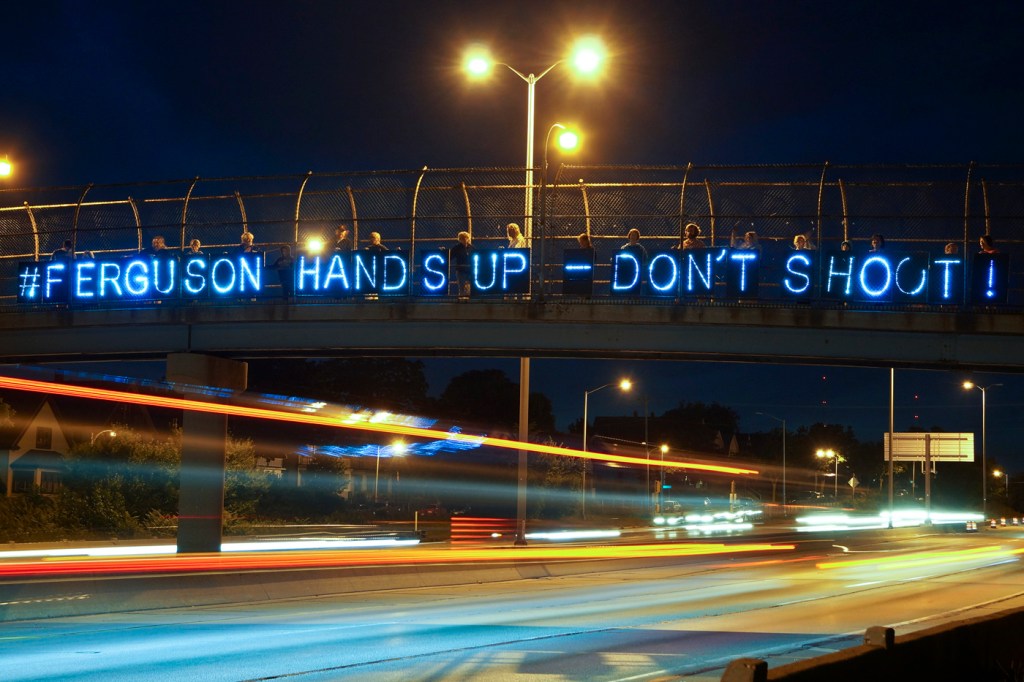3Qs: Citizen journalism in Ferguson

Tensions have escalated in Ferguson, Missouri, following the Aug. 9 shooting death of Michael Brown, an unarmed African-American teenager, by a white police officer. The incident has led to peaceful protests as well as clashes between the community and the police, and citizen journalists have been reporting on the ground via social media to help spread the story across the globe. Sarah Jackson is an assistant professor of communication studies in Northeastern University’s College of Arts, Media, and Design. Her research and teaching focuses on how social and political identities are constructed in the public sphere, with a particular focus on how race and gender are constructed in national debates around citizenship, inequality, and social movements. Here, Jackson examines both the citizen journalists and mainstream media’s coverage and their future implications.
The events in Ferguson have been brought to the public eye on both a national and global level by mainstream media as well as citizen journalists and others via social media. What’s your impression of how these two have covered the events in Ferguson, and how have they differed?
What is very important about the way the killing of 18-year-old Michael Brown and the resulting protests and unrest in Ferguson have been covered is that they likely would not have received as much coverage or context in mainstream news if it were not for citizen journalists. We saw something very similar with the Trayvon Martin case, where local activists and citizen journalists began tweeting about the injustices they felt existed in how little attention mainstream America was paying to the profiling and shooting of a teenager. The power of social media is that these regular people, in both Michael Brown and Trayvon Martin’s cases, were able to use hashtags, retweets, and image shares to show Americans from all across the country what was happening in their home towns. In the days after Michael Brown was killed, Twitter exploded with an image of his uncovered dead body lying in the street, an image taken on a camera phone by a neighbor. The anger and sadness this among other images and tweets stirred made Michael Brown’s death a trending topic.
As the protests erupted in Ferguson and as police escalated their tactics in response, social media has played a very similar role. Whereas many mainstream news sources only began covering the story a week after Brown’s killing and sometimes focused attention entirely on sensational images like the looting of local business, social media coverage from citizen journalists was there from the beginning and tackled some of the toughest questions around the story early on—like those about racial profiling, police brutality, and the militarization of local police forces. The push of these topics from citizen journalists, many whom are Gen-Xers and millennials and who are quick to post information online, has shaped mainstream coverage in that mainstream journalists had to respond, at least to some extent, to the issues being discussed in social media.
The most significant reasons why mainstream news coverage of these type of events is important is that traditional news still reaches more Americans than online citizen journalism and that government is more likely to respond to conflicts if mainstream media has deemed them important. It is no coincidence that the Justice Department, Attorney General Eric Holder, and President Obama did not respond to events in Ferguson until after mainstream media had raised the story to one of prominence, but the visibility of the story, the speed at which it spread, and the availability of information directly from the Ferguson community would not have been possible without citizen journalists and social media.
What are the implications—both positive and negative—of the differences between how Ferguson has been covered in these two ways?
I tweeted several days ago that all journalism students should read the 1968 report from the Kerner Commission on Civil Disorders. The commission, established by President Lyndon B. Johnson to better understand the race riots that broke out across America in the late-1960s, determined that many aspects of racial inequality, including housing discrimination, police profiling, and poverty, contributed to this unrest. The commission also included very harsh criticism of mainstream journalists for not more fairly reporting on the experiences of African Americans in general and for relying too heavily on sensationalism in their reporting of civil unrest. I think it would be useful for all journalists to reflect on these findings in the wake of what has happened in Ferguson. There are eerie similarities.
Citizen journalism has emerged as a powerful media tool in recent years, including during the Arab Spring and Occupy movements. How has citizen journalism evolved with the coverage in Ferguson, and what does it say about how this activist form of newsgathering and reporting may continue to evolve in the future?
Certainly the Arab Spring, Occupy, and the events in Ferguson and those that have focused on similar incidences (like the Trayvon Martin, Renisha McBride, and Oscar Grant shootings) have shown us that citizen journalism and social media are powerful tools for shaping what mainstream media is willing to talk about. As citizen journalists have pushed mainstream journalists to cover these stories, more Americans and people worldwide have been drawn into important conversations on the social issues they raise. Despite early attempts to dismiss social media and citizen journalists, these events have all shown that they can help organize social movements and work to spread information that might otherwise be ignored. Mainstream media has begun to adapt by necessity. We now see young journalists working for traditional media, like Wesley Lowery of The Washington Post (formally of The Boston Globe) heavily using Twitter alongside traditional avenues for reporting from Ferguson.






